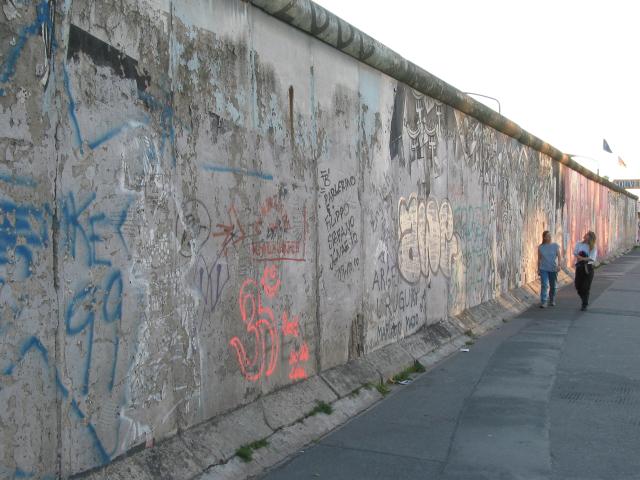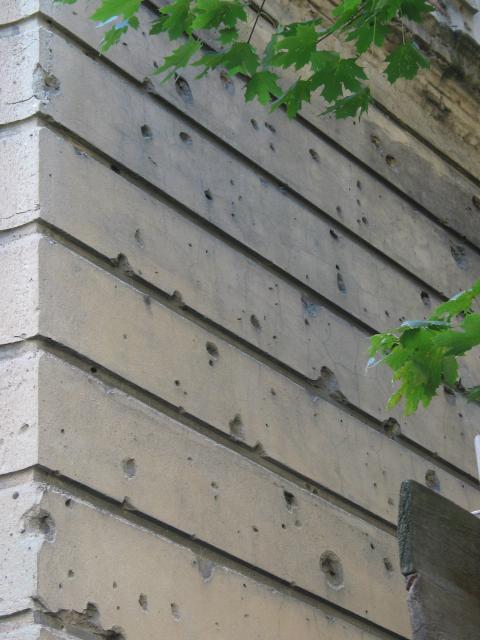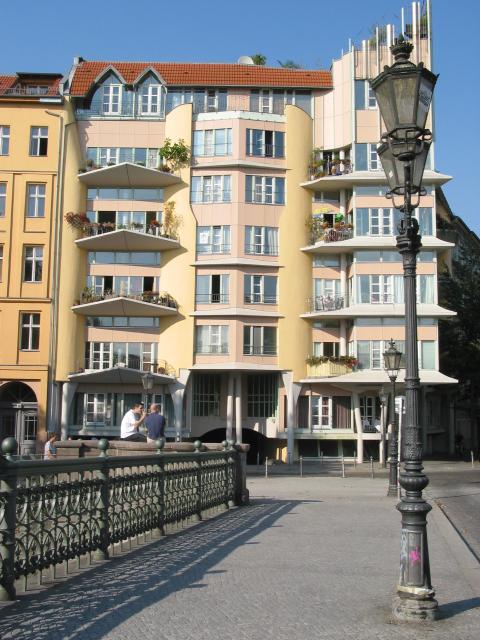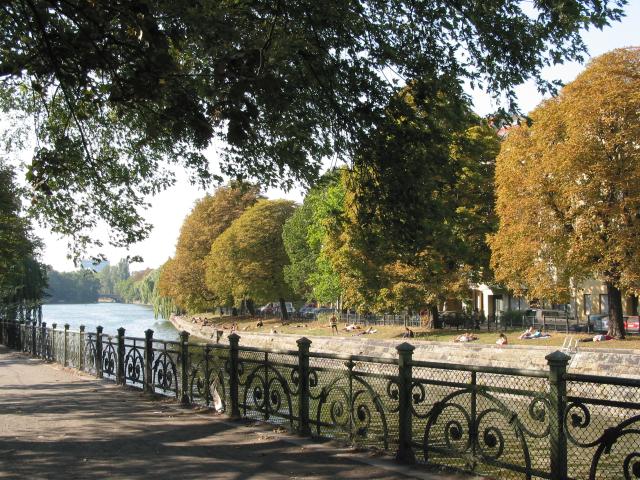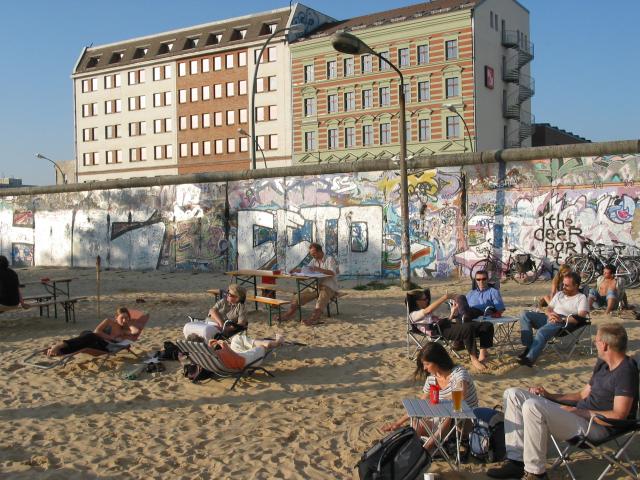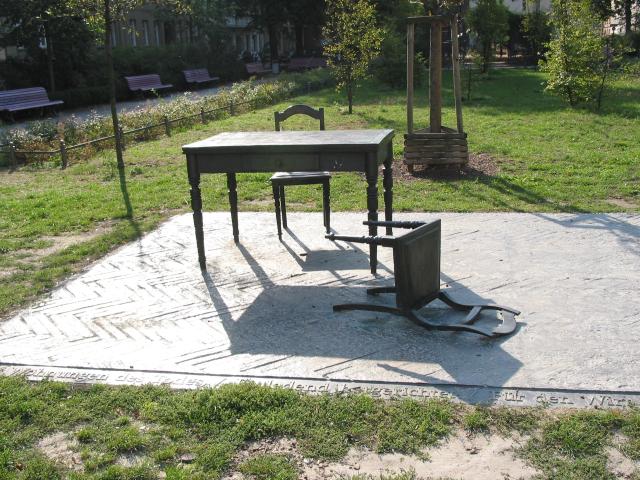
Photo Tour: Walks Around Berlin
What can I say about Berlin in just a few paragraphs -- or show
about
it in just a few photos (after only a week here... on my first visit)?
It's a huge city, about 50 km (30 miles) across, with incredible change
happening everywhere, over and over again for the past century.
Berlin was ripped apart by World War I and by the peace treaty,
its cultural essence (and many of its people) destroyed by the Nazis,
bombed into rubble during World War II,
and cut in two by the Soviets.
Through all of that, Berliners have survived and thrived and rebuilt
(and rebuilt...).
Even today (September 2003), nearly bankrupt, Berlin is rebuilding
itself --
and its peoples' vibrant lives go on.
I met some of those people during my visit: the dignified and
gracious
owner of the bed & breakfast where I stayed (a former flight
attendant
for Air France who also happened to be gay), a newspaper reporter, my
walking tour guide... all of whom moved to this city from
somewhere very different and stayed because they loved its vitality,
its diversity, and its differences from the rest of Germany.
I did a lot of walking: with an all-day
walking tour,
also by following routes in my
guidebook,
and by wandering on my own.
Here are a few of the zillions of photos I took. (There are more on the
following pages.)
To get a larger version of any picture, click on it; a new window
should open. When you close that window, this window should still be
here.
At the left below is the Luftbrückendenkmal, a huge
monument to the Berlin Airlift. After WWII, the western sectors of
Berlin were an island in the middle of East Germany.When the eastern
government tried to blockade the western part of the city (breaking the
three rail and road links that were the city's lifelines, symbolized by
those three prongs), pilots from the West flew one plane every 90
seconds for almost a year to keep West Berlin alive.
The East German government eventually ended the blockade and went on
building its socialist society... while the West went a different way,
rebuilding its part of Berlin into a capitalist city with virtually no
unemployment. Citizens of the East voted with their feet and fled to
the West in huge numbers until the eastern government decided to stop
the refugees. At 1 AM one night, barbed wire went up, separating
families from each other. It was followed by several versions of the
Berlin Wall, each stronger than the last one -- eventually becoming two walls, with a "death strip"
no-man's land between. Most of the wall came down in 1989, but the path
of missing parts is now marked by a line of bricks -- and, near the
Brandenburg Gate (which was between
the walls), the concrete marker at the right below:
|
After the Wall was finally
broken in 1989, parts of it were moved around the city (and around the
world) -- and many were painted, like the section at the right. It's
next to the former Palace of Tears, a building near Friedrichstrasse
train station, where people who'd been separated could cross over to
see loved ones for a short while. Visitors went through those doors,
and long lines of weeping family members lined up with them outside.
A long section of the original wall is still standing just east of the
Spree River. One side, next to a road (Mühlenstrasse),
is mostly covered with graffiti -- as you can see at the left below.
The other side, next to the river, has become a gallery for artists
from all over the world called the East Side Gallery.
|
After the Wall (well, most of it) came down, and the two
Germanys reunited, much of the former East Berlin looked just as it did
after the war ended: bomb-damaged buildings and bullet-riddled walls
like the one at the left below. Most of that is gone now, though, in a
flurry of reconstruction that has changed the face of the city -- like
the restored apartments along the Landwehrkanal, below at the right:
|
The Landwehrkanal, a canal
running through Berlin, has peaceful walks -- and a beach alongside
parts of it, too, where people were enjoying an Indian-summer
afternoon. And, although life's stll no "beach" for a lot of the former
East Berliners -- whose part of the city, and country, is still far
different than what was the West -- they still make the best of it,
like these people on a beach that's sandwiched between the Spree River
and the former Wall.
|
In the middle of all the signs
of Berliners' resilience, though, are signs of their past troubles. The
Nazis' racist and homophobic campaign to "purify" Germany (and Europe)
meant that -- like the Communists would do later with their Wall --
Jewish families were torn apart. The memorial below left, in Koppenplatz, is
to family members who were suddenly taken away -- by a knock on the
door -- never to return to their homes.
On the right are the two steel plates that cover the entrance to
Hitler's bunker -- where he and his new wife Eva Braun killed themselves as the
Russians closed in, just a kilometer or so away. There's no memorial
there, no sign: the bunker is underneath a courtyard and a parking lot,
next to a childrens' playground and some apartment blocks. If you
suspect that Germans are hiding their history by "burying" Hitler in
this way, though, I suspect that you're wrong. People here are all too
aware of their past -- and, I think, are remembering it as they move on
to make a better society. Berlin, especially, is that kind of place.
|
[Previous page: Lyme Regis,
England]
[Next page: Potsdamer Platz,
Berlin]
[Tour start: Around the World 2003]
[Tours]
(These photographs are Copyright © 2003 by Jerry Peek.
Much higher-resolution versions of most images,
and many other images too, are available at
Jerry Peek Photography.
Photos are available at reduced prices, or free, for non-commercial use.)
Contact us



